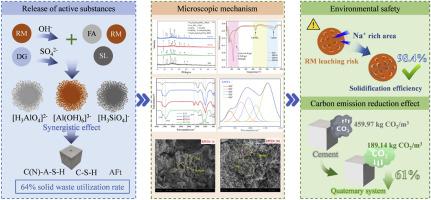Why does quaternary outperform ternary and binary? Unveiling the synergy of multi-component solid waste in sustainable low-carbon cementitious materials
IF 5.8
2区 化学
Q2 CHEMISTRY, MULTIDISCIPLINARY
引用次数: 0
Abstract
Solid waste-based cementitious materials effectively reduce environmental pollution and cement industry carbon emissions. However, excessive solid waste use may degrade materials properties. To address this challenge, this study proposes a quaternary solid waste synergistic activation strategy, aiming to simultaneously enhance the utilization rate of solid waste and optimize materials performance. Through systematically comparing the mechanical properties, microstructure and environmental behavior of binary, ternary and quaternary system, the strengthening mechanism of the quaternary system was clarified.
The results indicate that the quaternary system exhibits superior comprehensive properties, achieving a 28 d compressive strength of 45.33 MPa, which represents a 6.6 % and 37.5 % improvement over the ternary and binary systems, respectively. The key mechanism involves the synergistic activation of alkaline and sulfate solid wastes, enhancing the reactivity of silicate-aluminate components. This promotes the interwoven coexistence of gel and ettringite, increasing the proportion of gel pores (<10 nm) to 30.81 % and optimizing the pore structure. Furthermore, the system achieves a Na+ solidification effect of 98.4 % for red mud, ensuring controllable environmental risks. Additionally, the carbon emission is reduced to 189.14 kg CO2/m3 (a 59 % reduction compared to pure cement), while the carbon emission per unit strength decreases by 61 %, demonstrating significant dual-carbon-reduction characteristics and supporting its feasibility as a sustainable and low-carbon cementitious materials.
This study confirms that the synergistic effects of multiple solid wastes can overcome the traditional performance limitations of cement, providing a theoretical foundation and technical pathways for the efficient resource utilization of solid wastes and the development of low-carbon building materials.

为什么四元制优于三元制和二元制?揭示多组分固体废物在可持续低碳胶凝材料中的协同作用
固体废物基胶凝材料有效地减少了环境污染和水泥工业的碳排放。然而,过度使用固体废物可能会降低材料的性能。针对这一挑战,本研究提出了第四季固体废物协同活化策略,旨在同时提高固体废物利用率和优化材料性能。通过系统比较二元、三元和四元体系的力学性能、微观结构和环境行为,阐明了四元体系的强化机理。结果表明,四元体系表现出优异的综合性能,28 d抗压强度为45.33 MPa,比三元体系和二元体系分别提高了6.6%和37.5%。其关键机理是碱性和硫酸盐固体废物的协同活化,增强了硅酸盐-铝酸盐组分的反应性。这促进了凝胶和钙矾石的交织共存,将凝胶孔隙(<10 nm)的比例提高到30.81%,并优化了孔隙结构。此外,该系统对赤泥的Na+固化效果达到98.4%,确保了环境风险可控。此外,碳排放量减少到189.14 kg CO2/m3(与纯水泥相比减少了59%),而单位强度的碳排放量减少了61%,显示出显著的双碳减排特性,并支持其作为可持续低碳胶凝材料的可行性。本研究证实了多种固体废物的协同效应可以克服水泥的传统性能限制,为固体废物的高效资源化利用和低碳建材的发展提供了理论基础和技术途径。
本文章由计算机程序翻译,如有差异,请以英文原文为准。
求助全文
约1分钟内获得全文
求助全文
来源期刊

Sustainable Chemistry and Pharmacy
Environmental Science-Pollution
CiteScore
8.20
自引率
6.70%
发文量
274
审稿时长
37 days
期刊介绍:
Sustainable Chemistry and Pharmacy publishes research that is related to chemistry, pharmacy and sustainability science in a forward oriented manner. It provides a unique forum for the publication of innovative research on the intersection and overlap of chemistry and pharmacy on the one hand and sustainability on the other hand. This includes contributions related to increasing sustainability of chemistry and pharmaceutical science and industries itself as well as their products in relation to the contribution of these to sustainability itself. As an interdisciplinary and transdisciplinary journal it addresses all sustainability related issues along the life cycle of chemical and pharmaceutical products form resource related topics until the end of life of products. This includes not only natural science based approaches and issues but also from humanities, social science and economics as far as they are dealing with sustainability related to chemistry and pharmacy. Sustainable Chemistry and Pharmacy aims at bridging between disciplines as well as developing and developed countries.
 求助内容:
求助内容: 应助结果提醒方式:
应助结果提醒方式:


